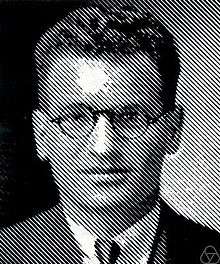Leo Zippin
Leo Zippin (1905 – May 11, 1995) was an American mathematician.[1] He is best known for solving Hilbert's Fifth Problem with Deane Montgomery and Andrew M. Gleason in 1952.

Biography
Leo Zippin was born in 1905 to Bella Salwen and Max Zippin, who had emigrated to New York City from the Ukraine in 1903. He did his undergraduate and graduate work at the University of Pennsylvania in 1929. His doctoral adviser was John Robert Kline.
Leo Zippin is the author of The Uses Of Infinity, and together with Deane Montgomery, the monograph Topological Transformation Groups. In 1952, he, along with Andrew M. Gleason and Deane Montgomery solved Hilbert's fifth problem.[2][3]
Personal life
He married Frances Levinson in 1932. They had two children, Nina, a prominent literary critic and literary historian, and Vivian.[4] He taught at Queens College in Flushing, NY.
References
- "Leo Zippin, 90, Dies; Solved Math Puzzle". NY Times. May 20, 1995.
- Stein, Howard (1977). "Some Philosophical Prehistory of General Relativity". In Earman, John; Glymour, Clark N.; Stachel, John J. (eds.). Foundations of space-time theories. U of Minnesota Press. pp. 38–. ISBN 978-0-8166-0807-2. Retrieved 22 May 2011.
- Montgomery, Deane; Zippin, Leo (May 1952). "Small subgroups of finite-dimensional groups". Proc Natl Acad Sci U S A. 38 (5): 440–442. doi:10.1073/pnas.38.5.440. PMC 1063582. PMID 16589121.
- known as Vivian B. Narehood, an attorney at Gibbel Kraybill & Hess Archived 2013-12-05 at the Wayback Machine
External links
- O'Connor, John J.; Robertson, Edmund F., "Leo Zippin", MacTutor History of Mathematics archive, University of St Andrews.
- Leo Zippin at the Mathematics Genealogy Project